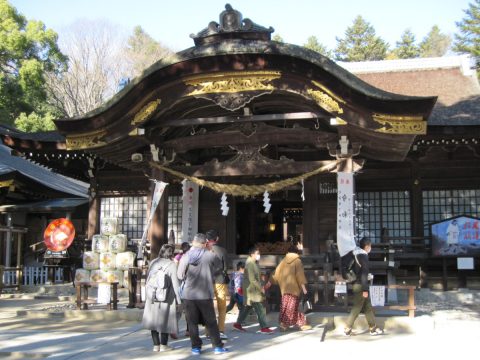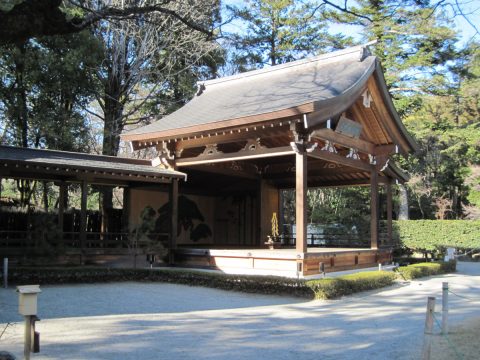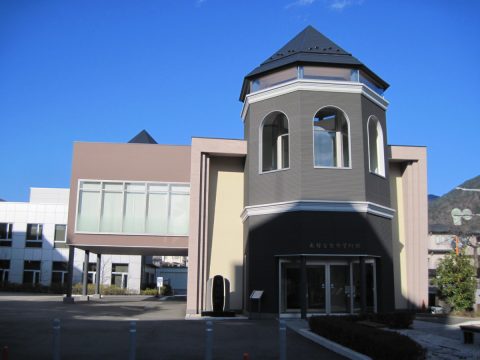I walked from Kofu Station to Takeda Shrine and back.
Since I took the same route, I will mainly write about the return trip.
Takeda Shrine
From Kofu Station to Takeda Shrine, it was a constant climb, perhaps because of the fan-shaped terrain.
The elevation near Kofu Station is 277 meters and the elevation at the intersection in front of Takeda Shrine is 342 meters, so I climbed 65 meters. If I assume that each floor of a building is 3 meters high, that’s more than 20 floors high. No wonder it is so tiring.
Takeda Shrine is the place where Nobutora, the father of Shingen Takeda, settled and later Shingen also lived here.
This is the second time I have been to Takeda Shrine.
The last time was probably about 10 years ago. After that, I learned from some reading material that there was a defensive device at the eastern Ote (main gate). The gate was designed to be safe from the inside, but difficult to attack from the outside.
I thought it would have been destroyed by now, but when I went back to the site, I found that it was still standing as a “Main gate of the Takeda clan house (Takeda-shi yakata-ato ote)”. This is it!
As I read the description with excitement, I found out that this structure was a reconstruction of a stone fort built by a vassal of Toyotomi Hideyoshi after the fall of the Takeda clan. What a pity!
It is assumed that a moat was dug in the shape of a crescent moon in the time of the Takeda clan.
Looking back, the remains of the Ote-mon gate. The left and right sides are moats. There was a little water on the left side, but the right side was an empty moat.
The Treasure Hall is on your right as you enter. (The photo was taken looking back as I passed by.)
There seems to be a special display of the Fuurinkazan military flag. At the entrance, Kitty is guarding it. The birthplace of Sanrio is Yamanashi Prefecture, so it’s not incongruous.入ってすぐの右手に宝物殿があります。
The main shrine was full of worshippers.
This is the water from the Princess Well (Hime-no Ido).
It seems to have originated from the fact that it was used for the birth of Shingen’s eldest daughter.
There was also a Noh stage in the precinct.
There doesn’t seem to be a storm door. I wonder if it is exposed to the elements.
When I came here before, I was able to go to the back of the Noh stage, but it was now off-limits.
This is the view from the shrine’s torii gate, looking toward Kofu Station.
The road runs straight through.
I don’t think there was a gate here in Shingen’s time. There may not have been a road here either. But the view must have been good even then.
The gable-roofed building at the end of the moat on the left is the Kofu City Takeda Clan Site History Museum, which was just opened on April 5, 2019. The permanent exhibition room is free, and the special exhibition room costs 300 yen.
I saw the free permanent exhibition. It was mainly a panel exhibition that introduced the activities of the Takeda clan.
Satoshi Omura Memorial Museum of Science
Halfway between Takeda Shrine and Kofu Station, the campus of the University of Yamanashi spreads out on both sides of the road.
When I looked down, I saw the words “Satoshi Omura Memorial Museum of Science”.
It was open, so I took a look around.
Inside the museum, there was a display of the Nobel Prize medals that Dr. Omura had won.
It was the first time for me to see the actual medal, so I was very impressed.
The medal was a photographic display, as he wore it and had the opportunity to attend meetings.
I also learned that the Imperial Seal is on the certificate for the Order of the Sacred Treasure and the Imperial Name and Seal is on the certificate for the Order of Cultural Merit.
There was also a copy of his thesis from his student days.
In addition to his achievements, there were also some rare crystals on display.
When I was there, there were no other visitors, so I was able to take my time and enjoy the rich contents of the exhibition. I highly recommend visiting the museum if you are ever in the area.
Around Kofu Station
I wonder if Yamanashi Prefecture, which produced Professor Omura, has a thriving education system. There are many prep schools here and there.
Look, here’s another one.
There are two prep schools in one building.
This is the Yamanashi Prefectural Library.
I went inside and found the space to be spacious and magnificent.
Most of the people were wearing masks, probably as a precaution against coronavirus.
Now, here’s a question.
Who is the designer of the building consisting of circular pillars seen on the other side of the library?
Incidentally, this is the building of the Yamanashi Broadcasting System (YBS).
The answer is Kenzo Tange. He also designed the Tokyo Metropolitan Government, the Yoyogi First Gymnasium, and the Tokyo Cathedral of St. Mary’s Cathedral. Each building has its own personality, and it is clear that he was an architect with many drawers.
When you come to Kofu Station, you have to see this too.
This is the statue of Takeda Shingen.
The area in front of Kofu Station seems to change a little bit every time I come here.
Walking data
Course: Kofu Station, JR Chuo Line -> Takeda Shrine -> Kofu Station, JR Chuo Line
Distance: 4.0km
Time: 2h10m
















